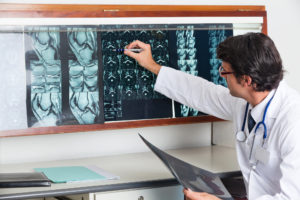Radiologists are required to participate in a minimum of 13 years of training. Although extensive knowledge and experience are vital to physicians who specialize in radiology, they make mistakes just like other doctors and healthcare providers. A study published in the medical journal Radiology found that among 8,401 radiologists across 47 states, 31 percent faced at least one medical malpractice lawsuit during their time in practice.
Let’s take a closer look at what research shows about the prevalence of medical malpractice lawsuits among radiologists, and the most common types of radiology errors. For additional information about injuries caused by radiology mistakes, contact Fronzuto Law Group to speak with one of our experienced New Jersey medical malpractice attorneys.
What is Radiology?
Radiology is a specialized area of medicine that involves the use of medical imaging technology. In most cases, radiologists (medical doctors who practice radiology) use imaging tests to diagnose diseases and medical conditions within the body. Less commonly, radiologists are involved in the treatment of disease.
A radiologist is typically engaged in the diagnostic and treatment process when your referring physician orders imaging tests and asks the radiologist to provide their expert opinion about the test results. Interpreting the results of an MRI, CT scan, PET scan, mammogram or other imaging technique is a vital role for doctors who practice radiology. Sometimes, the radiologist will concentrate on a subspecialty of radiology involving the cardiovascular system, lungs, breasts, gastrointestional system, or a specific type of patient population such as pediatrics.
Do Radiology Errors Happen Often?
Patients rely on radiologists, radiology technicians, and other healthcare providers involved in the diagnostic and treatment process to effectively perform their roles. The radiologist needs to accurately interpret the test results and communicate effectively with the referring physician about their diagnosis and recommended treatment. The radiology technologist needs to operate the machine and perform the tests correctly in order to deliver accurate imaging results. The doctors, nurses and others involved must provide correct instructions and documents to the patients about how to prepare for the imaging tests. When considering all of the necessary steps in the radiology process, it is easy to see where errors often occur.
Prior research found that although radiologists represent only 3.6 percent of all doctors in the U.S., they ranked sixth among all specialists in terms of the number of medical malpractice claims between 1985 and 2002. The data shows that radiologists have been sued for medical negligence more often than cardiologists, plastic surgeons, anesthesiologists, and gastroenterologists.
Top Radiology Mistakes
According to the aforementioned research, entitled “The Causes of Medical Malpractice Suits against Radiologists in the United States,” errors in diagnosis comprise the overwhelming majority of causes in medical malpractice suits against radiologists. Among diagnostic mistakes, breast cancer is the most frequently missed diagnosis. When a radiology error involves failure to diagnose breast cancer, this life-threatening disease can progress into its later stages, at which point the prognosis worsens for the patient.
The second-most commonly misdiagnosed condition among radiology malpractice suits is nonspinal fractures, followed by spinal fractures. When a bone fractures in the body, fragments can disperse and damage surrounding tissues and nerves. Missing this type of serious condition can lead to worsening pain and complications. Lung cancer is the next missed diagnosis in the context of radiology, which can allow cancer cells that originate in the lungs to spread to other parts of the body, making it more difficult to treat. The next most frequently missed diagnosis is vascular disease, encompassing a vast array of heart conditions that can include diseased arteries and blood vessels, structural problems in the heart itself, and blood clots. An undiagnosed heart condition often requires immediate medical intervention, as it can quickly turn deadly.
After missed and misdiagnoses, the next category of radiology errors is procedural complications, meaning errors that occur during a procedure using an imaging technique. The next broad category is communication errors either between the radiology team and the patient or between the radiologist and the referring physician.
Did a Radiology Error Leave You with Injuries in NJ?
Any type of radiology mistake can have catastrophic results. Patients may be left with severe injuries, permanent complications, or even die because of errors in radiology. When these tragic events occur, it is important to know your rights and legal options. If you would like to speak with an experienced radiology malpractice lawyer about your specific case, contact Fronzuto Law Group at 973-435-4551 or fill out our convenient online form. One of our attorneys will be happy to discuss your potential claim and provide you with a free case evaluation.


